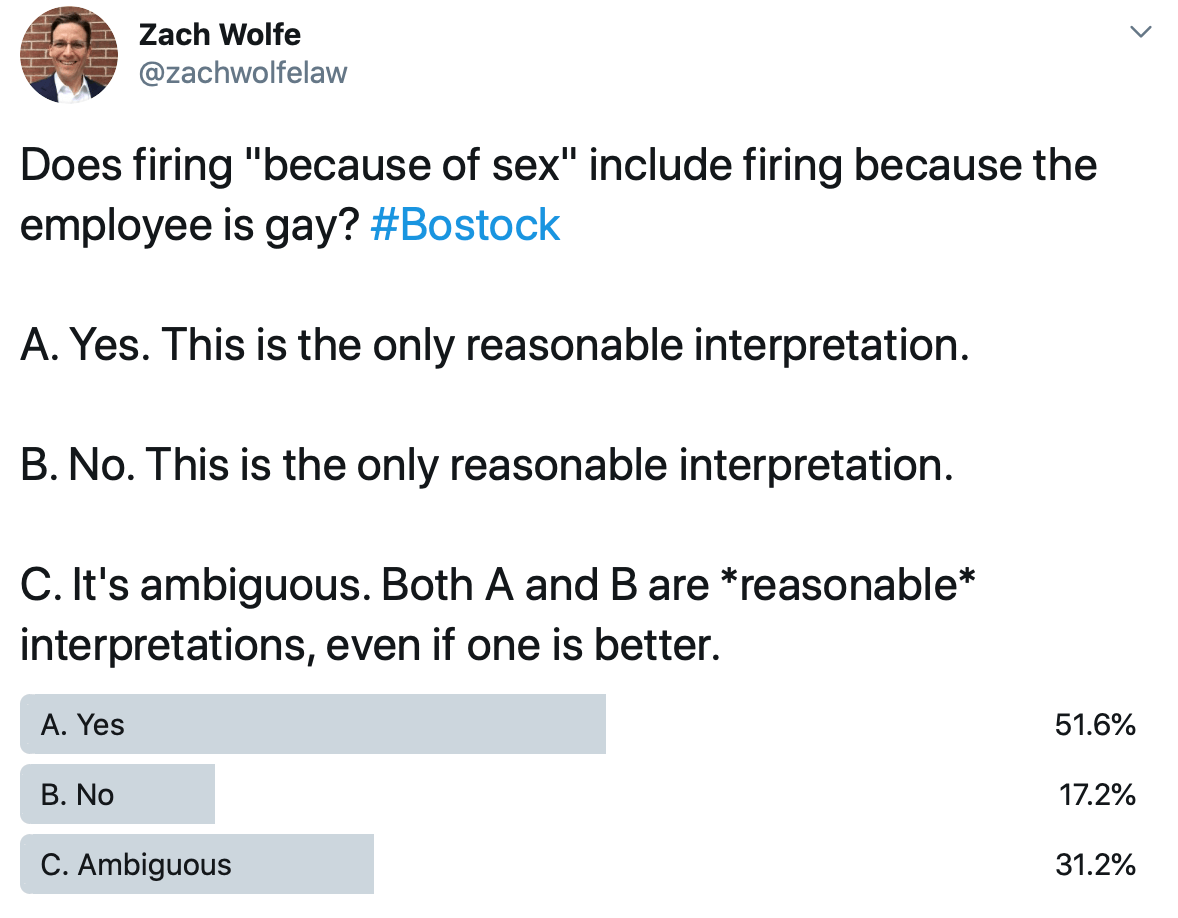Survey says . . .
I’m going to ask you to take an opinion poll.
But first, I have one small request: put aside, for a moment, whether you think discriminating against homosexual or transsexual employees is wrong, or whether you think it should be illegal. Easy, right?
Now here’s the question: Do you think that an employer firing an employee because the employee is gay is firing “because of sex”? You’ve got three choices:
A. Yes. And this is the only reasonable interpretation.
B. No. And this is the only reasonable interpretation.
C. Maybe. The phrase “because of sex” is ambiguous. Both A and B are reasonable interpretations, even if one is better.
If you picked A, you agree with Justice Gorsuch, who wrote the majority opinion in Bostock v. Clayton County. If you picked B, you agree with Justice Alito, who wrote a scathing dissenting opinion. If you picked C, then you agree with Five Minute Law.
Notably, both Gorsuch and Alito purported to apply the method of judging known as “textualism.” My thesis is that this teaches us an important point about textualism: it fails to deliver on its central promise of providing an objective, determinate, non-political basis for deciding hard cases.
Let’s break it down.
What is Strict Textualism?
First we need to distinguish between two kinds of textualism. For convenience, I’ll label them “Modest Textualism” and “Strict Textualism.”
Modest Textualism says when interpreting a statute the court should start with the text. If there is only one reasonable interpretation of the text of the statute, the court should stop there and not consider extrinsic sources.
“Extrinsic” sources means everything other than the text, but most notably, it could include what Congress intended the words to mean, how courts have interpreted the text in the past, pragmatic factors, and considerations of what is fair, just, or good public policy.
Virtually everyone who is serious about the law is at least a Modest Textualist. No serious practitioner—i.e. a judge or practicing lawyer—says “in interpreting a statute, the text of the statute is totally irrelevant.”
No. Everyone agrees you start with the text. Of course you start with the text.
The difference of opinion arises when different people interpret the text differently.
Even then, the Modest Textualist does not immediately jump to extrinsic sources. The mere fact that two litigants disagree over the statute’s interpretation does not mean the court has to look beyond the text. A party’s proffered interpretation must be at least reasonable. The court can reject an unreasonable interpretation without looking beyond the text.
But what if I told you that sometimes, just sometimes, there is more than one reasonable interpretation of a statute? Not only that, but once in a blue moon, there are two reasonable interpretations of a statute that lead to diametrically opposite results.
That’s called a Hard Case. And that’s where Modest Textualism and Strict Textualism part ways.
In a Hard Case, the Modest Textualist says ok, there are two reasonable interpretations of this statute. That means the statute is ambiguous as applied to this dispute. So we’re going to have to look to something else to decide which interpretation to adopt. The text alone just doesn’t give us the answer.
And of course, I’m joking when I say “once in a blue moon.” This happens all the time, at least in the kind of case that makes it up to the Supreme Court. And as a practicing litigator, I can tell you it even happens fairly often in the kind of boring, ordinary business disputes I handle.
So what should the judge do in such cases?
In theory, the Strict Textualist agrees that when a statute is ambiguous, the court can look to extrinsic sources. The difference is that the Strict Textualist tries really, really hard to avoid jumping to extrinsic sources too quickly. The Strict Textualist will first use close reading of the statute, “canons of construction,” and dictionaries to interpret the statute. It is only when those methods fail to yield a clear answer that the Strict Textualist will even consider looking to extrinsic sources. (In theory)
This immediately raises a complication, because Strict Textualism does allow the judge to look at the “ordinary public meaning” of the statute at the time it was enacted, which can include looking at dictionaries, which are an extrinsic source.
And Strict Textualism has a close cousin named Originalism, which says you must look to extrinsic sources—e.g. the Federalist Papers—to interpret the “original understanding” of the Constitution, especially considering that the broadly worded text of the Constitution just doesn’t give you the answers to Hard Cases.
But for simplicity, let’s just say the Strict Textualist tries really hard to confine the inquiry to the text.
You might object to my sharp distinction and argue the difference between the Modest Textualist and the Strict Textualist is only a matter of degree. And you’d have a point. But still, the difference is pretty easy to spot in the wild. If a judicial opinion gets down into the punctuation of a statute and parses multiple definitions of ordinary words from multiple dictionaries, that’s probably a Strict Textualist writing the opinion.
You might also object that my distinction is too abstract. So far, I’ve ignored the elephant in the room (no pun intended). Strict Textualists are almost always Republicans.
Now, in the abstract, there is nothing inherently “liberal” or “conservative” about either form of textualism. But in practice, one political ideology tends to favor Strict Textualism.
Everybody knows that conservatives and Republicans like Strict Textualism, while liberals and Democrats like Modest Textualism. But why is that? Modest Textualism does not necessarily lead to a liberal result, and Strict Textualism does not necessarily lead to a conservative result (again, in theory), so why the stark difference?
I’ll come back to that. First we need to understand the rationale behind Strict Textualism.
Strict Textualism’s Central Promise
The rationale behind Strict Textualism has two parts.
First, Strict Textualism says that judges must have an objective, non-political basis for deciding Hard Cases. Otherwise, judges would just be deciding cases based on their own personal opinions on what is fair, just, or good public policy. That would not be the rule of law, the proponent of Strict Textualism says. That would be legislating.
Thus, even if Strict Textualism did not exist, the Strict Textualist says, judges would have to invent it.
Second, Strict Textualism says that Strict Textualism provides an objective, non-political basis for deciding Hard Cases. When Strict Textualism is applied correctly, it yields a single determinate answer, even in Hard Cases where there appear to be strong arguments on both sides. This is the central promise of Strict Textualism.
Now, let’s clear aside one obvious objection to this central promise. Strict Textualism does not claim that the answer will always be obvious, or that all reasonable people will agree on the answer.
No, the Strict Textualist realizes that reasonable people will disagree on the correct application of Strict Textualism. Not only that, even the foremost legal experts, or even members of the Supreme Court, will sometimes disagree. But the fact that they disagree doesn’t change the fact that there is still a single correct answer.
The Strict Textualist might analogize to medicine. Two doctors who are renowned experts in their field could examine the same patient and come up with diametrically opposite diagnoses. The fact that they disagree does not change the fact that only one of them is correct. The one true diagnosis is “out there,” even if it is sometimes hard to discern.
So even if judges applying Strict Textualism sometimes get it wrong, the important thing is that they apply it, Strict Textualism says. That is the only way to maintain the rule of law and avoid turning judges into de facto legislators.
In short, Strict Textualism promises political legitimacy.
And one more thing. The corollary is that other theories of adjudication are illegitimate. Strict Textualism does not just claim to provide determinate answers to Hard Cases. It claims to be the only theory of adjudication that does so (with the possible exception of Originalism, but that’s another can of worms).
This turns Strict Textualism into a sword that can be used to attack a judicial decision as not only wrong, but as illegitimate. This is the key to its political appeal. And for various reasons I don’t have time to get into here, this appeal is especially strong for conservatives.
But does Strict Textualism deliver on its promise? Oh, if only we had a test case.
Enter Bostock.
Bostock v. Clayton County
Bostock is almost the perfect test case for Strict Textualism. It has it all: a hot-button social issue that turns on the interpretation of just three words in a statute, i.e. “because of sex.”
Specifically, Bostock presented a question of statutory interpretation concerning Title VII of the 1964 Civil Rights Act: does discrimination “because of sex” include discriminating against an employee for being a homosexual or transsexual. Writing for the 6-3 majority, conservative Justice Gorsuch said yes.

In a role reversal, Justice Gorsuch’s opinion offered a “textualist” rationale for this “liberal” result. Chief Justice Roberts, another conservative, joined in the Gorsuch opinion, along with the four liberal justices. The three most conservative justices—Alito, Thomas, and Kavanaugh—dissented.
Justice Gorsuch reasoned that the text of the statute provided one—and only one answer—to this question. Therefore, it did not matter what Congress intended when it passed Title VII of the Civil Rights Act of 1964. “When the express terms of a statute give us one answer and extratextual considerations suggest another,” he wrote, “it’s no contest.” Only the “written word” is the law.
This was textbook Strict Textualism, at least on its face. “This Court normally interprets a statute in accord with the ordinary public meaning of its terms at the time of its enactment,” Gorsuch wrote.
And he offered the textbook justification for this method of adjudication: constraining judges and thereby providing legitimacy. “If judges could add to, remodel, update, or detract from old statutory terms inspired only be extratextual sources and our own imaginations,” he said, “we would risk amending statutes outside the legislative process reserved for the people’s representatives.”
Justice Gorsuch then made a painstaking logical argument for why the plain meaning of “because of sex” necessarily includes sexual orientation and gender identity. Under the Supreme Court’s precedents, discrimination “because of sex” means any discrimination where the individual’s sex is a “but for” cause of the employer’s action. Applying that standard, Justice Gorsuch reasoned, there is just no way for an employer to take an action because of an individual’s sexual orientation or gender identity that does not in some way take into account the individual’s sex. His logic hypotheticals would make the LSAT proud.
Some of you will buy his argument, and others will not. I’ll wager this will depend largely on whether you think discrimination on the basis of sexual orientation or gender identity should be illegal or not. It will be a rare case where someone says “I strongly believe discrimination based on sexual orientation should be against the law, but the statute simply doesn’t say that,” or vice-versa.
I only hope you will agree that Justice Gorsuch’s interpretation of “because of sex” is at least one reasonable interpretation. I mean, he’s a pretty smart guy, with generally conservative views. The idea that he just made it up to “appeal to college campuses and editorial boards” doesn’t seem credible. And the justices who joined him are intelligent too. They all have degrees from fancy law schools and years of judicial experience.
Of course, none of this proves they are right, but isn’t the fact that six out of nine justices on the highest court in the land agree with this interpretation some indication that their interpretation is at least reasonable? Surely they haven’t all lost their minds.
Alito’s Dissent
So how did Alito respond? Ever the gentleman, he began by saying:
My learned colleague Justice Gorsuch has written an opinion that sincerely attempts to decide this hard question through the good-faith application of textualism, a theory we both agree with, but I fear he has gone astray and applied the method incorrectly.
I’m kidding, of course. It was quite the opposite. Alito’s anger was palpable. He lashed out at Gorsuch’s opinion as not only incorrect, but as dishonest and illegitimate. “There is only one word for what the Court has done today: legislation,” he led off. “The document that the Court releases is in the form of a judicial opinion interpreting a statute,” he said, “but that is deceptive.”
Why so angry?
I think it was a combination of three things. First, the result. Second, the fact that Gorsuch and Roberts joined the liberals. Third, and perhaps the most galling, was the fact that Gorsuch wrote a textualist opinion justifying the result. “The Court’s opinion is like a pirate ship,” Alito wrote. “It sails under a textualist flag,” he said, but it actually reflects the illegitimate theory that courts should “update” old statutes so they reflect the “current values of society.”
Let’s put aside Alito’s anger for the moment and just look at what the disagreement tells us about textualism.
Alito characterized the majority opinion as holding that the only reasonable interpretation of “because of sex” is that it includes sexual orientation and gender identity. In Alito’s words, the majority argued “not merely that the terms of Title VII can be interpreted that way but that they cannot reasonably be interpreted any other way.” “According to the Court,” he said, “the text is unambiguous.”
On this point Alito got the majority opinion right. Gorsuch did not argue that “because of sex” is ambiguous and then offer an argument for choosing one of two reasonable interpretations. No, Gorsuch argued that application of the plain meaning of the statute yields only one result: discrimination based on sexual orientation or sexual identity is inherently discrimination “based on sex.”
Alito wasn’t buying it. “The arrogance of this argument is breathtaking,” he wrote. “The Court’s excuse for ignoring everything other than the bare statutory text is that the text is unambiguous,” Alito said, “and therefore no one can reasonably interpret the text in any way other than the Court does.” But “to say that the Court’s interpretation is the only possible reading is indefensible.”
You might expect Alito’s next move to be an argument that the majority’s interpretation is only one reasonable interpretation, and that the statute is therefore ambiguous.
But no. Alito believes that the majority’s interpretation is not only wrong, but that his opposite interpretation is the only reasonable one. In other words, Alito would pick option B, not C, in my opinion poll above. “The Court’s argument is not only arrogant,” he said, “it is wrong.”
Alito argued that “because of sex” does not include sexual orientation or gender identity. He supported his interpretation with evidence that included:
- The fact that Congress has considered—but rejected—attempts to amend the statute to expressly add “sexual orientation” and “gender identity.”
- Dictionary definitions showing that “sex” did not mean “sexual orientation” or “gender identity” in 1964. (Remember, textualists love dictionaries.)
- The fact that ordinary people in 1964 would not have understood “discrimination because of sex” to include discrimination because of sexual orientation or gender identity. (This is textualism’s “ordinary public meaning.”)
- Evidence that Congress didn’t intend to prohibit discrimination based on sexual orientation or gender identity.
I’ll let others get into the weeds on these points. Conservatives will tend to find Alito’s evidence compelling. Liberals will tend to reject it.
I only hope to make the modest point that Alito’s interpretation of the statute, like the majority’s, is at least one reasonable interpretation.
Ask people on the street, either today or in 1964, if discrimination “based on sex” includes discrimination based on sexual orientation—without telling them the effect of their answer—and plenty of people will say no. As Justice Kavanaugh emphasized in his separate dissent, textualism means applying the “ordinary” meaning of a phrase, not the “literal” meaning of an isolated term.
Surely, Justice Alito’s interpretation of “because of sex” to mean “because the person is male or female but not because of that person’s sexual orientation” is at least one reasonable interpretation, even if you ultimately disagree with it.
Failure to Deliver
If I’m right—if both Justice Gorsuch and Justice Alito have reasonable interpretations of the statute—then Bostock shows that Strict Textualism fails to deliver on its central promise, at least in practice.
Remember, the promise was that Strict Textualism would provide an objective, determinate way to decide Hard Cases, i.e. a method that would yield only one correct answer. But Strict Textualism had its chance in Bostock, and it failed spectacularly.
Instead of a single correct answer, there was a reasonable textualist argument for construing the statute one way (Gorsuch’s) and a reasonable textualist argument for construing it the other way (Alito’s). That left each side to pick the reasonable interpretation that would yield the result it wanted. The fact that each side acted like its interpretation was the only reasonable one did not change this.
Thus, Strict Textualism did not provide any constraint on the justices choosing the interpretation they considered fair or just. In other words, it did not prevent them from making a political judgment about the better outcome.
Objection, the Strict Textualist says, Bostock proves no such thing. The mere fact that judges will sometimes disagree over the result of applying Strict Textualism does not mean that Strict Textualism fails to provide a determinate answer, the Strict Textualist will protest. Remember the medical analogy.
This argument strikes me as plausible in theory, but unpersuasive in practice. I’m not saying Strict Textualism must provide a determinate answer that is obvious to everyone. But if Strict Textualism cannot yield an answer that can be demonstrated to people skilled in the law to be the single correct answer, I just don’t see how it provides any meaningful constraint on judges. In practice, it simply fails to provide the special legitimacy it claims.
But doesn’t this leave us in an untenable state of affairs? If Strict Textualism fails to deliver on its central promise, doesn’t that mean that judges will be allowed to do what Justice Alito accused the Bostock majority of doing, legislating instead of judging? And if judges decide cases based on what they think is fair or just, do we even have the “rule of law”?
Fair questions, but there are no easy answers. Trouble is, there’s just no avoiding this problem. You can argue that judges shouldn’t decide cases by picking the interpretation they think is fair and then reasoning their way into that interpretation. But isn’t that effectively what judges are already doing—what they’ve always done—regardless of the label they put on it, and even if they sincerely think they are doing something else?
We just have to muddle through somehow.
_____________________________________

Zach Wolfe (zach@zachwolfelaw.com) is a Texas trial lawyer who handles non-compete and trade secret litigation at Zach Wolfe Law Firm. Thomson Reuters named him a Texas “Super Lawyer”® for Business Litigation in 2020 and 2021.
These are his opinions, not the opinions of his firm or clients, so don’t cite part of this post against him in an actual case. Every case is different, so don’t rely on this post as legal advice for your case.




Comments:
Outstanding analysis. Personally I believe the logic process leading up to the conclusion by Justice Gorsuch was impeccable. However, I may be overstating my assessment. Strict textualism seems to attempt structuring a legal reasoning process as seeking some sort of mathematical perfection. After all, isn’t math the ultimate in human reasoning? This quest could be a deceitful goal. At least that is the finding of Kurt Godel, perhaps the greatest mathematician of the 20th Century and one of history’s outstanding logicians. As I understand, and that is an extremely limited understanding, he proved that mathematics is not inherently perfect, that a mathematical theorem, basically a statement or proposition, can be both true and false or neither true nor false at the same time. Same goes for logic which we rely on in our legal reasoning. On a separate point, putting aside the dispute over the text, a very important part though not always as emphasized in analysis of the reasoning in the opinion of Justice Gorsuch is he discussion about the causation standard. He appears to broaden the application of the but-for standard. This could be very important in future sex discrimination cases whether brought by gay or straight plaintiff’s. Because the standard for causation applies to either same sex or heterosexual situations, this has the potential for an even broader impact than the issue of whether the phrase “because of sex.”
Thanks, Stanley! Great feedback from you as always. The point about mathematics is interesting. And I agree, Justice Gorsuch’s “but for” analysis is strikingly broad. I expect we will see plaintiffs citing it in a lot of “ordinary” employment discrimination cases.